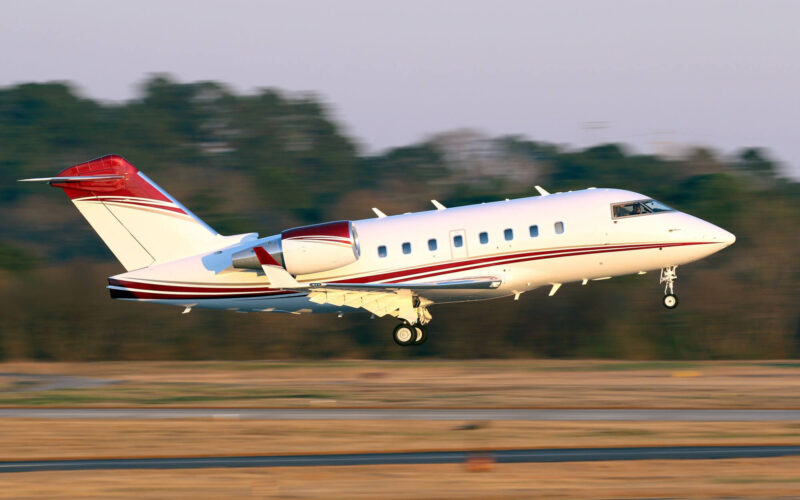UK aviation accident investigators have issued a special bulletin after the flaps on a Bombardier Challenger 604 extended inadvertently, potentially endangering the safety of the aircraft.
The business jet, registration D-AAAY, departed Farnborough Airport (FAB) at 16:18 UTC on August 10, 2022, to carry out a private charter flight to Málaga – Costa Del Sol Airport (AGP) in Spain. Onboard were three crew and seven passengers. After the flaps extended uncommanded during the climb out, the crew took action, landing back at FAB at 16:51, with no injuries to anyone on board.
The investigation is still ongoing, but the incident, classed as serious by the UK Air Accidents Investigation Board (AAIB) is concerning enough that a special bulletin has been issued, with one safety recommendation and four safety actions for the manufacturer and Canadian regulator, including checks to aircraft and providing operators with information on the occurrence.
Flaps extending in flight is a potentially catastrophic event, meaning one that could lead to the aircraft being destroyed and/or multiple deaths.
On this occasion, the crew were closely monitoring the aircraft while it was still in the climb phase of flight and so were able to react quickly.
“Had the aircraft been in the cruise, the crew may not have been able to recognise the uncommanded flap extension so promptly and take corrective action within the time required for the flaps to fully extend,” the AAIB wrote in the special bulletin, published on September 22, 2022.
What happened to the flight?
The twin-engine plane took off without incident from FAB and the crew retracted the flaps. However, at around 16:40, when the autopilot was engaged and as the Challenger was passing through Flight Level 190 (approximately 19,000 feet) at an indicated airspeed of some 300 knots, the crew were alerted to a flap failure caution message.
However, despite the plane’s speed being above the maximum speed at which the flaps can be safely operated, there was no flap overspeed audio warning.
The captain took control of the aircraft, slowed it down and descended the aircraft. The cabin crew member checked the flaps through the window and saw they were fully extended. This was in spite of the flap lever being in the 0 position, where the flaps should be fully retracted.
The pilots returned to Farnborough, where the plane landed safely at 16:51, albeit slightly over the maximum landing weight.
What has the investigation found so far?
The AAIB reports that after the aircraft had landed, engineers from a maintenance company began work to ascertain what caused the defect reported by the flight crew.
They report: “The aircraft was left parked with electrical power applied and the aircraft powered up. After approximately two hours, the flaps extended fully without command. The flap selector lever in the cockpit was in the flap 0 position.”
The investigation is ongoing and has not yet determined the reason for the uncommanded flap extension.
However, the investigation is also looking at why a system to protect against an uncommanded movement of the flaps did not work as expected. If the flaps extend without being commanded, the protection system is supposed to cut power to the two motors driving the flaps and stop the flaps from extending further. However, the AAIB said it appears that a fault with a relay in the No 1 motor meant it continued to operate, thus allowing the flaps to continue extending at half their usual speed.
In the safety case for the Bombardier Challenger 600 Series aircraft, the analysis of an uncommanded flap extension concluded that two failures – one to cause the flaps to move, and a second to prevent the movement from being arrested – would have to occur at the same time for the flaps to extend uncommanded beyond a certain point.
However, in this event, it appears that a failure of the No 1 retract relay was enough to disable the protection system, meaning only an uncommanded flap movement was enough to extend the flaps.
“The safety case for an uncommanded flap movement was calculated assuming two concurrent failures, but this event shows that it is possible for one failure to exist undetected for some time, thereby increasing the risk of this potentially catastrophic event occurring,” the AAIB said.
The actions and recommendations
In the first safety action, Transport Canada and Bombardier are reviewing the safety case for the flap operating system of the Challenger 600 series of aircraft to ensure that the safety risk probability of an uncommanded flap movement is correct.
In the second, Bombardier will advise operators of Challenger 600 aircraft of the occurrence to D-AAAY by 20 October 2022.
In the first safety recommendation, Bombardier has been recommended to inform operators of the actions to take in the event of uncommanded flap operation in flight.
The fact that a relay was broken meant that the flaps had been retracting at half their normal speed during the 64 previous flights recorded on the flight data recorder, a state that is not announced to crew.
Because other aircraft in the fleet may be operating with a similar latent failure, the Bombardier and Transport Canada will take two safety actions to advise operators to check the speed movement of flaps and ensure that mandatory inspections are carried out.
The full special bulletin is available here.

